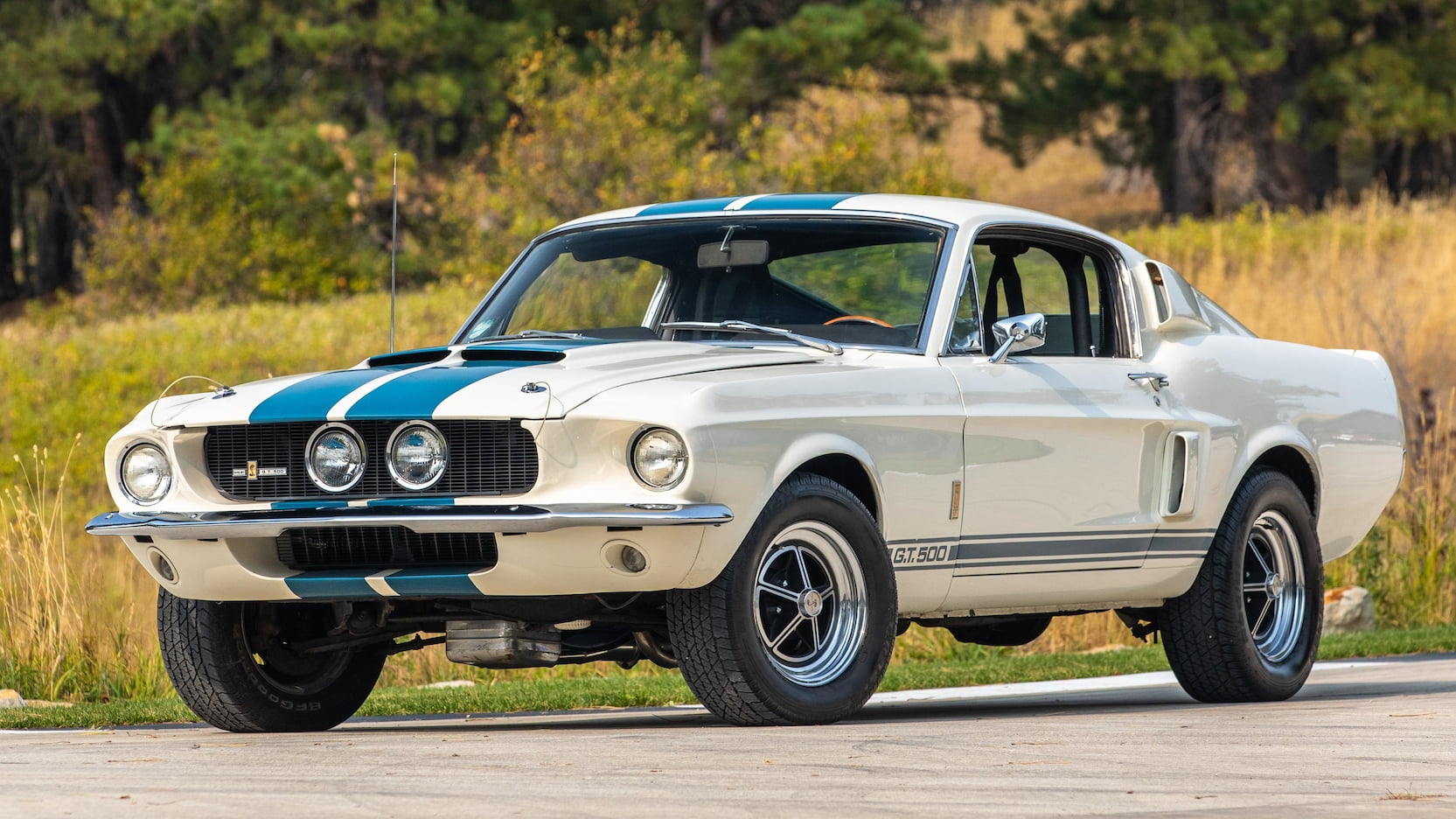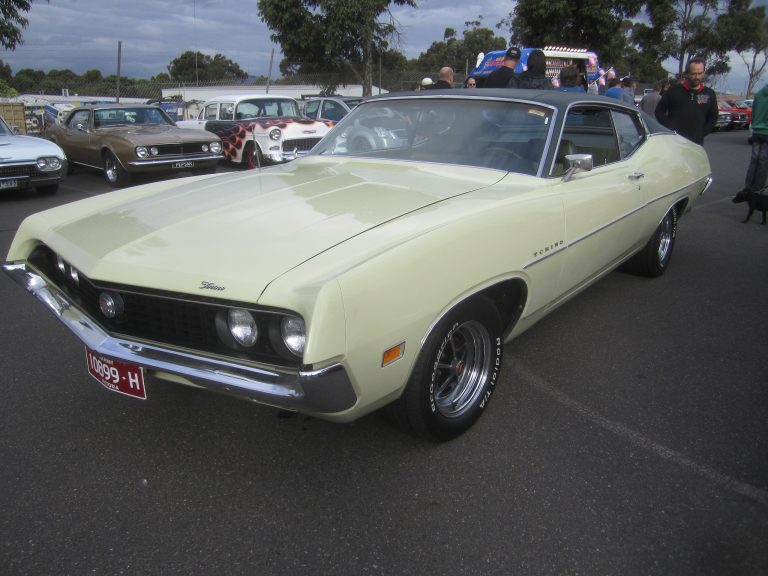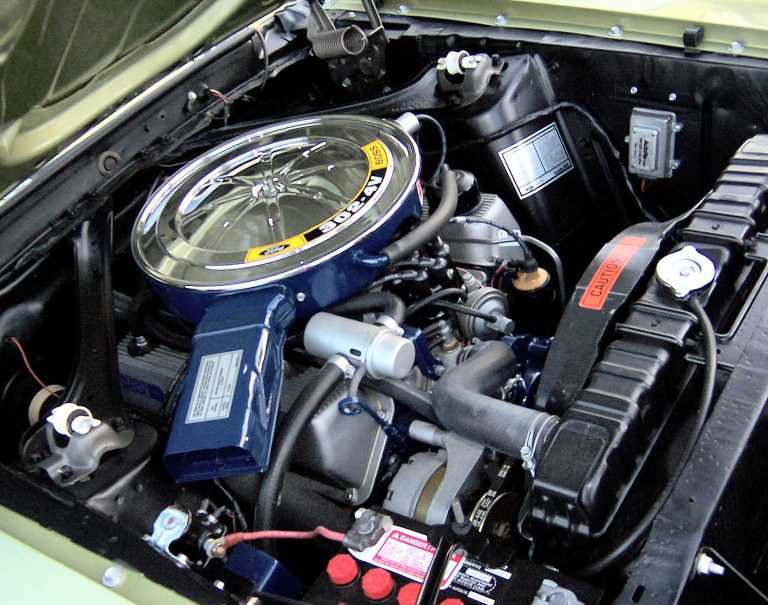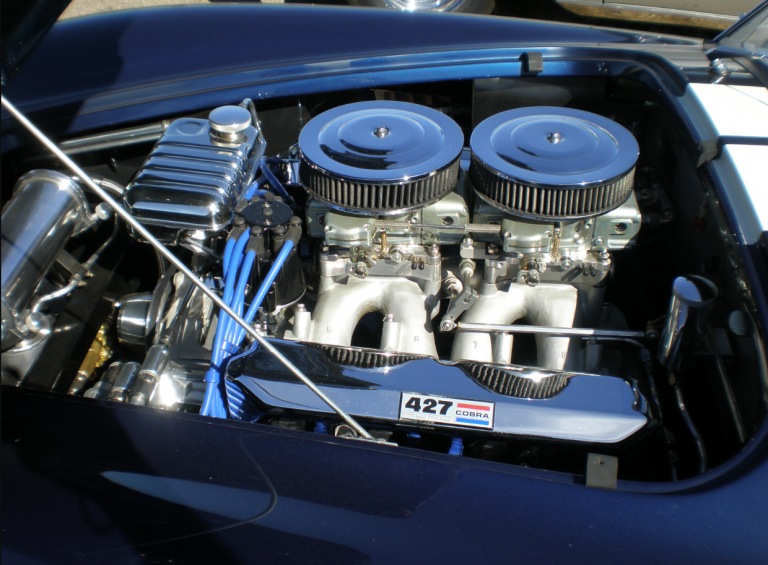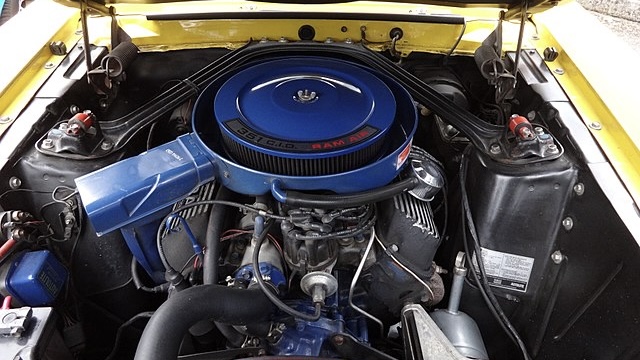Shelby GT500 History and Specs

Meet Austin
Austin has been a muscle car enthusiast since an early age with his Dad having a collection including a 1965 Mustang, 1968 Mercury Cougar, and a 1969 Mustang Mach 1 among many others. Austin received a technical writing degree from University of Colorado Denver with the intentions of becoming an automotive journalist. His automotive knowledge, enthusiasm, and hands on experience allow him to craft detailed, accurate, and high-quality articles for the passionate Muscle Car Club audience.
It truly speaks to Carroll Shelby’s legacy that nearly everyone stateside and abroad can conjur up a mental image as soon as the term “GT500” is brought up. Of course, the GT500 is only a small part of Shelby American’s extensive and decorated history. Fostering a special relationship with eventual Ford president Lee Iacocca, Carroll Shelby played an instrumental role in integrating Ford into the world of motorsport. As a key decision maker in the Ford GT40 project, which scored a 1-2-3 finish at the 1964 24 Hours of Le Mans, Shelby transformed the Ford Mustang into a dedicated performance machine.
While the Shelby GT350 preceded the GT500 and has an extensive history of its own, the GT500 represented the best that Shelby had to offer on the Mustang platform. Over the model’s history, the GT500 was built on either 2 or 3 generations of Ford Mustang depending on how you classify the S197 facelift chassis. While the GT350 was initially built to put up a fight around circuits, the GT500 was designed for the drag strip. While the drag strip dedication would eventually die off on with the later generations of GT500, it would eventually become a solid American All-arounder. Over the model’s history, the GT500 was built on either 2 or 3 generations of Ford Mustang depending on how you classify the S197 facelift chassis.
In this guide, we cover the famous Shelby GT500 in detail, covering the history of one of the most famous American cars ever made.
First Generation (1967-1970) Shelby GT500 History
While the GT500 was unquestionably the example that Carroll Shelby and Shelby American sought to set, it wasn’t the first Ford Mustang-based performance car that the company produced. That goes to the Shelby GT350 which was released two years before the GT500 in 1965. While the GT350 was unquestionably a no-nonsense track animal, Shelby aimed for a slightly more “pedestrian” goal with the GT500.
1967 Shelby GT500
While the term “pedestrian” is quite a stretch when referring to the first-generation GT500, it did include features such as power steering, power-assisted brakes, and air conditioning. I suppose that made it more of a grand tourer than anything. The GT500 was meant to bridge weekend trip comfort with face-deforming performance which it undoubtedly succeeded at. In contrast to the GT350 which utilized a 289 K-code V8, the GT500 received a larger 428 Police Interceptor engine that featured a number of benefits over the more powerful 427 found in the GT40.
While even the 428 Police Interceptor engine was part of the Ford FE engine series which would eventually go on to power Ford cars in NASCAR and other racing series, it was a friendlier engine for consumers than the race-oriented 427. The 428 Police Interceptor V8 was a consumer engine used primarily in larger Ford models, making it a more reliable and easier-to-live-with option over the more powerful 427. Many people believe that the GT500 was potentially producing more than the factory-rated 355 horsepower.
1967 Shelby GT500 Specs
| Car | 1967 Shelby Mustang GT500 |
| Engine | 428 Police Interceptor V8 OHV |
| Horsepower | 355 Horsepower |
| Torque (lb-ft) | 420 lb-ft |
| 0-60mph | 6.5 seconds |
| Quarter Mile Time | 15.0 seconds @ 95mph |
| Weight | 3,370 lbs |
| Production Numbers | 2050 vehicles made |
The 1967 Shelby GT500’s 15-second quarter-mile time made it one of the fastest cars on the road at the time. While 355 horsepower and 420 lb-ft of torque were middle of the pack when compared to other muscle and pony cars of the time, it was still plenty of power, especially for a car that weighed only a bit more than a ton and a half. Cars like the Dodge Coronet R/T and the Pontiac GTO could out-drag the GT500, but the Shelby name carried a lot of weight and pedigree. The Ford 428 CID V8 was fitted with two Holley 600 CFM carburetors and an aluminum intake manifold, boosting horsepower a bit from the 428’s factory power figure.
1968 Shelby GT500KR
After the first year of the Shelby GT500, Shelby was ready to introduce even more power to the equation. In 1968, Shelby unveiled the Shelby GT500KR, with the hanging letters representing the moniker “King of the Road.” The Shelby GT500KR was built on the redesigned 1967 Ford Mustang, which received functional-cosmetic changes including more pronounced front and rear styling which would allow for larger engines to be fitted under the hood.
Shelby took advantage of the facelift, fitting a massive 428 Cobra Jet V8 under the hood. The addition of the new single Holley 750 CFM carburated Cobra Jet engine was factory rated at the same 355 horsepower figure quoted for the original 428 found in the 1967 GT500. Enthusiasts would later discover that figure was massively underrated with the GT500KR’s actual horsepower figure closer to 435 horsepower. The 428 Cobra Jet V8 utilized freer-flowing cylinder heads and a less restrictive exhaust manifold which increased performance as a result.
Other differences between the GT500KR and regular Mustang GT model included a functional 2-point roll bar, a bespoke fiberglass hood, two massive functional air scoops on said hood, louvered cooling vents, side intakes, and an integrated deck spoiler. While a few of those aesthetic modifications were functional, including the hood scoops and deck spoiler, the majority were for the purpose of setting the GT500KR apart visually. It is unquestionable that the GT500KR stood out in the crowd.
1968 Shelby GT500KR Specs
| Car | 1968 Shelby Mustang GT500KR |
| Engine | 428 Police Interceptor V8 OHV / 428 Cobra Jet V8 |
| Horsepower | 355 horsepower / 435 horsepower true rating |
| Torque (lb-ft) | 440 lb-ft |
| 0-60mph | 6.9 seconds |
| Quarter Mile Time | 14.8 seconds @ 103mph |
| Weight | 3,570 lbs |
| Production Numbers | 1251 vehicles made |
On paper, the 1967 Shelby GT500 and 1968 Shelby GT500KR don’t appear to be that different. While they certainly do share many internal components, the 1968 Shelby GT500KR is unquestionably a step forward in terms of overall power. The 428 Cobra Jet V8 was undoubtedly a stronger powerplant due to larger valves, a better flowing cylinder head, and additional webs cast into the main bearing saddles. While it is said that both the 428 found in the 1967 GT500 and the 428 Cobra Jet were criminally underrated from the factory, the Ford CJ is certainly more powerful than the standard 428.
Despite the added power, the 1968 GT500KR did not reflect the power increase in a very dramatic way due to the added weight. The added 200 pounds, which can be attributed to the Mustang’s bulkier redesign, largely counteracted the more powerful engine, resulting in a slower quarter-mile time and a similar 0-60 time to the previous year’s model. The 1968 GT500KR is significantly rarer than the 1967 GT500, with only 1251 cars manufactured that year.
1969-1970 Shelby GT500
By the late 1960s, the Ford-Shelby alliance was beginning to falter. Beyond the 1968 Shelby GT500, Carroll Shelby had lost a lot of the creative freedom that he enjoyed, working on Shelby products outside of Ford’s intervention. In 1969, Ford took over the design and production duty of Shelby vehicles, producing them in-house rather than at Shelby headquarters in California. Shelby and Ford parted ways at the end of 1969 to pursue other endeavors.
As a result of the split, the 1969 Shelby GT500 was technically the last year of the original Shelby Mustang. With that being said, the 1969 Shelby GT500 was a solid entry in the Shelby product line. Like the cosmetic facelift that occurred between the 1967 and 1968 model year Mustang, the 1969 Mustang received a dramatic styling change. The most notable change was the lengthened hood and narrowed front facade. The lights previously resting outside of the front grille shroud were moved into the shroud which was chrome in color. Upon the revised hood were three triangular hood scoops which funneled air toward the 428 Cobra Jet engine.
The 1969 Shelby GT500 was the last iteration of the model. While there was technically a 1970 GT500, those cars were simply 1969 cars that were rebadged as 1970 models. There was no difference in performance, aesthetics, or interior decorations between the 1969 and 1970 model years. The GT500 model would be shelved for nearly 40 years between 1970 and 2007.
1969-1970 Shelby GT500 Specs
| Car | 1969-1970 Shelby Mustang GT500 |
| Engine | 428 Cobra Jet V8 |
| Horsepower | 355 horsepower / 435 horsepower true rating |
| Torque (lb-ft) | 440 lb-ft |
| 0-60mph | 6.0 seconds |
| Quarter Mile Time | 16.0 seconds @ 95mph |
| Weight | 3,849 lbs |
| Production Numbers | 1871 vehicles made |
Despite making use of the suspected 435 horsepower Cobra Jet V8, the 1969 and 1970 GT500 were the heaviest that the GT500 had ever been. Weighing in at 3,849 pounds, the 1969 Shelby GT500 was nearly 500 pounds heavier than the initial 1967 GT500. Quite a bit of that weight, once again, came from the redesign of the Ford Mustang. The 1969 GT500 was between 4 and 10 inches longer than the previous year’s model, tacking on a significant amount of weight.
As a result of the added weight, the 1969 and 1970 Shelby GT500 backtracked a bit in the quarter-mile department. As you can see by the numbers, the 1969-1970 GT500 is the first time that the model seemed to diverge from Shelby’s vision. The final model GT500 had a 0-60 time that was over a second slower than the previous year’s car which no doubt upset Mr. Shelby. Ford’s vision for the Shelby model line was heading increasingly towards the grand tourer route which justified the lesser performance.
Second Generation (2007-2014) Shelby GT500 History
The second generation Shelby GT500 was the first time that Shelby American and Ford had worked together on the model for nearly 40 years. With the S197 Mustang chassis harkening back to the classic models of the 1960s, it was the perfect platform for the two legendary companies to rekindle their past relationship. The 2006 Shelby GT-H was technically the first collaboration between Shelby and Ford on the S197 chassis, but the S197 GT500 would blow the GT-H out of the water in terms of performance and historical pedigree.
2007-2009 Shelby GT500
The S197 GT500 ushered in a new era of the Shelby/Ford partnership which thrust the legendary model into the 21st century. While the partnership was between Shelby American and Ford, Shelby worked in conjunction with the Ford Special Vehicle Team more specifically. The Ford Special Vehicle Team, or SVT for short, was created in 1992 when Ford recognized the benefits of catering to the enthusiast market. By the release of the S197 GT500 in 2007, SVT had already developed cars like the SVT Mustang Cobra and the F-150 SVT Lightning.
In fact, the majority of the 2007 Mustang GT500 was already completed by the time Shelby came aboard. Regardless, the second generation Shelby GT500 was the most powerful Mustang ever built at the time thanks to a 5.4L supercharged V8 producing 500 horsepower under the hood. The 2007 GT500 wasn’t the first time that a Shelby utilized forced induction. Harkening back to 1965, the Shelby GT350 was available with a factory-equipped Paxton supercharger, eventually becoming one of the most sought-after Shelby cars out there. The S197 Shelby GT500 was an homage to that legendary model.
The second generation Shelby GT500 was considered by many to carry on the GT500’s drag strip pedigree, with Ford opting to not include independent rear suspension on the new model. The solid rear axle made the drag racing community ecstatic and kept the GT500’s function pure. Styling unquestionably harkened back to the original models too. The 2007 Shelby GT500 featured the signature Shelby Le Mans stripes on coupe models.
2007-2009 Shelby GT500 Specs
| Car | 2007-2009 Shelby GT500 |
| Engine | 5.4L Supercharged V8 |
| Horsepower | 500 horsepower @6,000 rpm |
| Torque (lb-ft) | 480 lb-ft |
| 0-60mph | 4.5-4.7 seconds |
| Quarter Mile Time | 12.6 seconds @ 114.2 mph |
| Weight | 3,920-4,040 lbs |
| Production Numbers | 30,277 vehicles made |
Between 2007 and 2009, the Shelby GT500 remained largely unchanged outside of the introduction of several special edition models. The massive amount of power produced by the second-generation GT500 required Brembo brakes, suspension upgrades, and stabilizer bars to compensate. All of these upgrades allowed the GT500 to corner flatter and come to a stop faster. Obviously, as a car with 40-year-newer technology, the second-generation GT500 featured electronic aids. Most prominently, the 2007-2009 Shelby GT500 used an advanced four-channel ABS system and traction control.
However, despite all of the advanced technology, it must be said that the 0-60 and quarter-mile times of the 2007-2009 Shelby GT500 don’t reflect the 40-year gap between it and the first generation. While the 4.5-4.7 second 0-60 time is undoubtedly fast, the 12.8 second quarter mile time is somewhat underwhelming. A large limitation of the second-generation Shelby was its weight. At 3,950 pounds, the second-generation Shelby was significantly heavier than its competitors and its earlier self. The weight would ultimately be the second gen’s most significant issue, limiting acceleration and cornering.
However, Shelby did try to combat the issue with brute force through a couple of special editions. The 2008-2009 Shelby GT500KR paid homage to the GT500KR of 1968 and featured a 540 horsepower version of the supercharged 5.4L V8 which included a new cold air intake and a performance tune. The Shelby GT500 Super Snake was also offered from 2007 to 2009. Like the GT500KR, the Super Snake had an even more insane 605 horsepower output due to a larger displacement roots supercharger.
2010-2012 Shelby GT500
The 2010 model year didn’t mark a change in generations between Mustangs, but it did bring a significant aesthetic and performance facelift to the S197 chassis. Looking at the pre and post-facelift models side by side, you’d think the late model GT500 was a new machine. And, in some respects, it was. Overall chassis design remained largely unchanged, but the facelifted car features some notable design changes. One of the most significant design changes was the move from a power dome hood to a flush design. Other functional-aesthetic changes include the addition of a new low-drag wing and a more aggressive front splitter.
While the 2010-2012 Shelby GT500 still used the 5.4L V8 found in the early model, power was bumped to 540 horsepower. Shelby had learned from the special edition 2008-2009 GT500KR and pushed the envelope in terms of engine tuning. Like the model the year prior, the 2010-2012 Shelby GT500 used an updated suspension setup to accommodate for the added power. All-in-all, the 2010-2012 Shelby GT500 featured mainly cosmetic and interior upgrades that made it a more comfortable and capable version of the pre-facelift S197 GT500.
2010-2012 Shelby GT500 Specs
| Car | 2010-2012 Shelby GT500 |
| Engine | 5.4L Supercharged V8 |
| Horsepower | 540 -550 horsepower @6,200 rpm |
| Torque (lb-ft) | 510 lb-ft |
| 0-60mph | 4.5-4.1 seconds |
| Quarter Mile Time | 12.35 seconds @ 115.8 mph |
| Weight | 3,820-3,969 lbs |
| Production Numbers | 14,392 vehicles made |
Despite sharing quite a few specifications as the pre-facelift models, the late model 2010-2012 Shelby GT500 does benefit from some increased performance over the old model. Both the 0-60 and quarter-mile times of the newer model have reduced thanks to more power, less drag, and less weight.
The most significant change is the bump in horsepower to 540 horsepower – and later 550 horsepower – thanks to a new air intake design and increased boost pressure. 2011 and newer Shelby GT500s also made use of a much lighter aluminum block for the 5.4L supercharged V8 which removed nearly 100 pounds from the front end. Despite the additional power, altered gearing ratios made the post-facelift GT500 more fuel efficient as well.
In addition to changes in the 5.4L V8’s engine design, the 2010-2012 Shelby GT500 also utilized a strengthened 6-speed transmission that got rid of many of the reliability issues facing the transmission used in earlier cars. The 2011 Shelby GT500 introduced the SVT Performance Package which included a limited-slip differential, larger wheels and tires, and stiffer suspension.
While the differences between the 2007-2009 and 2010-2012 Shelby GT500 aren’t as extreme as they could have been, the added power certainly cut down on the facelifted model’s 0-60 time and quarter mile time. That is especially true for the post-2011 models with the aluminum block 5.4L V8, as weight was a serious problem with the S197 model.
2013-2014 Shelby GT500
The introduction of the 2013 Shelby GT500 marked the 6-year mark since the beginning of the renewed Shelby/Ford relationship. Despite the passing of nearly a half-decade, the 2013 Shelby GT500 was still built on the S197 chassis. While the underlying S197 platform was getting somewhat tired by 2013 and 2014, Shelby and Ford worked to make the refreshed version even more powerful and with even better handling.
As with the previous entry, very little changed in terms of aesthetic upgrades or functional aero modifications. However, there was one notable change to the front facade of the 2013 Shelby GT500. With a new and updated 5.8L supercharged V8 based on the previous 5.4L V8, the new engine which produced nearly 100 horsepower more than the previous year needed some additional airflow. The grill was designed to maximize airflow to the radiator and air-to-liquid intercooler for the new Eaton TVS supercharger.
Due to the new engine and weight characteristics that it brought with it, the 2013 Shelby’s suspension was also returned. Despite being very outdated compared to modern independent rear suspension arrangements, Shelby stuck with the solid rear axle for 2013. However, Shelby did have some suspension-related tricks up their sleeve. One example is the GT500’s use of an electronic adjustable Bilstein damping system. The 2013 GT500 also featured larger brakes and a larger front stabilization bar.
2013-2014 Shelby GT500 Specs
| Car | 2013-2014 Shelby GT500 |
| Engine | 5.8L Supercharged Trinity V8 |
| Horsepower | 662 horsepower @6,500 rpm |
| Torque (lb-ft) | 631 lb-ft |
| 0-60mph | 3.5 seconds |
| Quarter Mile Time | 11.6 seconds @ 125 mph |
| Weight | 3,845-3,982 lbs |
| Production Numbers | 9,701 vehicles made |
The performance increase from the 2012 Shelby GT500 to the 2013 GT500 is one of the largest cross-year improvements ever seen by the company. The 5.8L Trinity V8 is a beast of a powerplant, producing almost 100 more horsepower than the 5.4L. The most noticeable reason for the power increase is the displacement difference. The Trinity V8 was based on the 5.4L but with a larger bore. The supercharger was upgraded to a significantly larger 2.3L twin vortices Eaton TVS supercharger as well. In combination, the increased displacement and more potent supercharger boosted power to a neck-breaking 662 horsepower.
To compensate for the added power, the 2013 and 2014 Shelby GT500 used new cross-drilled blocks and heads, an upgraded head gasket, a carbon fiber driveshaft, and an upgraded clutch. And that is only the major stuff. The Tremec 6060 6-speed transmission also received a refresh with an even heavier-duty clutch. Gearing was also lengthened to help with fuel consumption, also giving the GT500 the ability to hit over 200 mph.
It feels like we have said this a number of times now, but the 2013 Shelby GT500 was the fastest car they’d ever made. With a 0-60 time of 3.5 seconds and a quarter-mile time of 11.6 seconds, that is unarguable.
Third Generation (2020-2022) Shelby GT500
The third-generation Shelby GT500 represents the best that Shelby and Ford have ever offered. We know, you’ve heard that before in the previous sections. At the risk of sounding repetitive, the 2020-2022 Shelby GT500 is not only the fastest GT500 ever, it is the most powerful car that Ford has ever produced. That is quite an accomplishment, especially considering the fact that Ford recently released the new Ford GT. Built on the S550 chassis, the 2020-2022 Shelby GT500 reaps the benefits of modern technology. Independent rear suspension was finally added to the GT500, making it one of the best handling Fords out there too.
2020-2022 Shelby GT500
Obviously, most of the draw of the new Shelby GT500 comes with the new powertrain. Producing 760 horsepower and 625 lb-ft of torque, the 2020-2022 Shelby GT500 produces over twice the horsepower that the original GT500 put out in 1967. The 2020-2022 Shelby GT500 shares more in common with the GT350 than ever before. Due to the fact that Ford and Shelby already had a solid starting platform in the third generation GT350 which they had been working on since 2015, the GT500 represents an even more beastly version of the less powerful model.
The 2020 Shelby GT500 introduced the 5.2L Predator engine; a significant upgrade from the 5.2L Voodoo engine found in the third-generation Shelby GT350. To compensate for the power and heat generated by the engine Shelby designers had to spend a deal of time working out how to properly cool the 5.2L beast and integrate it into the car most effectively. As a result, the 2020-2022 Shelby GT500 utilizes some serious aerodynamic trickery. The hood, splitter, and grille designs all play into its aerodynamic advantages while also making the GT500 look truly sinister. The interior of the third-generation GT500 is also a major step up. By 2014, the interior of the S197 was becoming increasingly stale. The 2020-2022 GT500 introduced more modern styling and electronic amenities that were absent in the previous generation.
2020-2022 Shelby GT500 Specs
| Car | 2020-2022 Shelby GT500 |
| Engine | 5.2L Supercharged Predator V8 |
| Horsepower | 760 horsepower @7,300 rpm |
| Torque (lb-ft) | 625 lb-ft |
| 0-60mph | 3.4 seconds |
| Quarter Mile Time | 11.3 seconds @ 132 mph |
| Weight | 4,171 lbs |
| Production Numbers | Approximately 14,116 vehicles made |
With the 5.2L Predator V8 under its hood, there’s no question that the 2020-2022 GT500 is the most powerful Mustang ever built. In fact, the Predator V8 has the best power-to-displacement ratio of any supercharged V8 in the world. The newest generation of Shelby GT500 is aimed squarely at the supercar market in contrast to its muscle car past. Like the Trinity V8 used in the previous generation, the 5.2L Predator features an aluminum block and a mighty roots-style supercharger. The Eaton TVS supercharger increased in size to 2.65 liters, which is a key contributing factor to the massive horsepower discrepancy between the Trinity V8 and the Predator V8.
In order to put the ludicrous amount of power to the road, Shelby opted to employ the 7-speed DCT out of the Ford GT in the GT500. The Tremec TR-9070 transmission has been quoted as one of the GT500’s strong points, with quick and effortless shifts that add a new element to the GT500’s on-track performance. Other elements of the GT500’s performance can be adjusted with drive mode selections which can stiffen up the GT500’s MagneRide, allow for faster shift times, adjust stability control settings, and adjust antilock brake characteristics. The 2020-2022 Shelby GT500 also has the most sophisticated suspension setup of any Shelby to come before it. Finally switching to independent rear suspension, the third-generation GT50 was truly transformed into a track animal.

